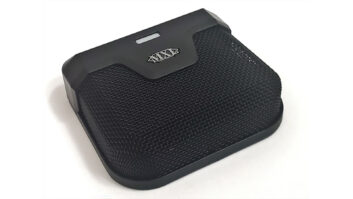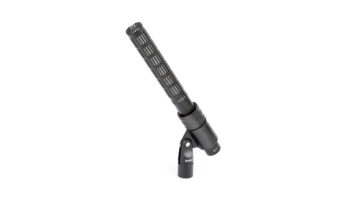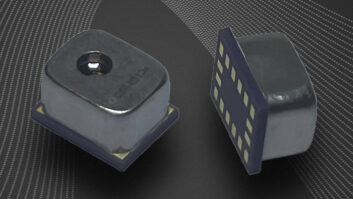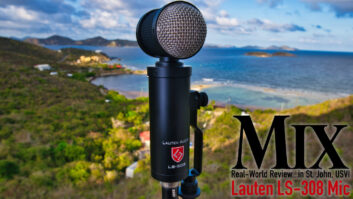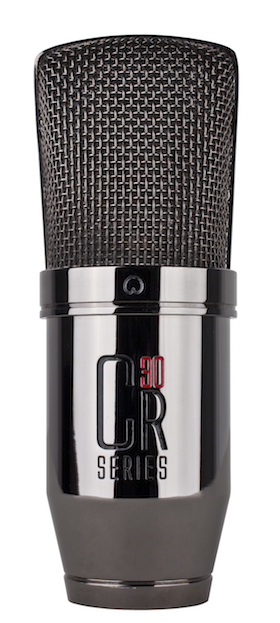
The MXL CR30 is a fixed-pattern condenser with a two-position pad.
Due to the boom in home and personal recording, a wide range of manufacturers offer value-based options from the beginning to end of the signal chain. Microphones in particular have seen a surge in affordable products that look a lot like their higher-priced cousins. The problem is in figuring out which of these can live up to the billing and deliver the goods.
Forums are filled with posts touting various mics as the secret weapon for this or that, but true value isn’t endemic to a mic that does one thing really well. If a microphone is going to earn a prominent spot in the locker, it needs to be well-constructed and possess the versatility to capture a wide variety of sources. To that end, MXL has consistently been at the forefront of creating quality microphones that are accessible to a broad base of users. I remember the first time I saw a v67 and how shocked I was when the guy told me what he had paid for it. The quality vocals we tracked that day only added to my surprise. The large-diaphragm, cardioid condenser CR30 is the latest addition to MXL’s family of microphones, and it proudly carries on the tradition of providing top-line performance without crushing the bottom line.
Out of the Box
The CR30 comes in a hard-shell case that holds the microphone, shock-mount and a microfiber cloth for polishing the attractive mirrored finish. The mic itself has a solid, weighty feel that inspires confidence in its ability to survive the toils of consistent use. The one switch for the onboard -20db/-10dB pad is firmly mounted and has a very positive transition from one position to the next. The robust windscreen shares the mirrored finish of the body and seems like it would also hold up well to use. The shock-mount is a typical MXL design that uses a metal frame with elastic cords providing suspension. A pair of wire handles release the tension of the cuff that holds the microphone in place. This feature makes it very easy to slip the CR30 in and out of the mount while maintaining a solid grip. Although the mount is functional, it doesn’t represent the same level of quality as the mic itself. The frame doesn’t seem like it would take much abuse, and the elastic is easily dislodged. Also the mount’s swiveling thread point is not as robust as I would like.
Into the Studio
The CR30 proved to be a willing partner in a number of applications. I first used it for a voice-over session with a corporate client. Not exciting work, but a good baseline test to see what the CR30 had to offer. The talent’s voice left much to be desired (okay, it was me) but the CR30 did not. I don’t possess a classic radio voice and could certainly use any help the mic had to offer. While the fairly transparent nature of the MXL didn’t miraculously transform me into VO star, its smooth and detailed response did create a workable version of my voice that was responsive to EQ and dynamics.
A percussion session for a children’s record seemed like a great opportunity to stretch the legs on this wide-bodied transducer. I decided to use the CR30 on everything we tracked to see how it would deal with the assortment of drums and toys. First up was a big metal snare drum being played with brushes. The CR30 accurately captured every detail of the swirling strokes and light brush hits. It also reached well beyond top head, pulling out the subtle sounds of the brass shell and gently excited snares. One thing the CR30 did lack was an airy top end. It wasn’t that it sounded flat or constricted, but it was missing some fairy dust that you get with world-class microphones.
As the day went on, we also tracked washboards, spoons, bottles and anything else that was sitting around the studio. The CR30 continually performed well, creating realistic renderings of everything that was placed in front of it. It should be noted that the mic was very lively and picked up a good bit of the room. This can be either positive or negative depending on the source, the space you’re recording in, and what you want out of the track. I found the lush reverberation of the snare to be a welcome addition while the sharp reflections of the washboard made it seem a touch distant. Like I said, this characteristic is neither good nor bad, but it should be understood and accounted for.
As I was wrapping up the evaluation process for the CR30, a friend called and asked if I could track some demos for him. Thinking that this would be a perfect test for the CR30, I set up a simple recording rig in my back room similar to the setups found in bedrooms and rehearsal spaces all over the world. The session began with the CR30 sitting in front of a beautiful Gibson Hummingbird. Resting over the 12th fret, the CR30 produced a well-balanced and lifelike image, capturing the warmth and subtle details of this fine instrument. The mic did exhibit a slight exaggeration in the low-midrange, but it wasn’t demonstrative or unpleasant. Like the snare, it was also missing some shimmer on the very top end but the track didn’t sound incomplete.
As we continued, the CR30 proved to be equally competent with vocals. This particular singer had a notably intricate voice with unique characteristics, a challenge for any microphone. The quick, detailed response and three-dimensional nature of the mic really made the vocal shine. It jumped out of the speakers and avoided the boxy feeling that is so common with less expensive microphones. As with the guitar, the low-midrange seemed a touch elevated and the highs needed a little shelving, but overall the response was very good. At mixdown the layers of acoustic and vocal parts fit together into a realistic blend that made you feel like you were in the space.
Countless Applications
It was refreshing to work with an affordable microphone that can truly hold its own in a wide variety of applications. The CR30 proved to be a versatile tool that is both attractive and well-constructed. It would be nice to have a low-frequency roll-off, but it appears that MXL chose to focus on the quality of performance and construction instead of features, a concept that other manufacturers would do well to employ. Having roll-offs, multiple pickup patterns or other options can only benefit a user when the microphone sounds good and doesn’t fall apart. The attractive appearance, quality build and excellent overall performance of the CR30 proved to be a winning combination. It would be a great addition to any studio that needs a flexible tool that can wear an assortment of hats and look good in all of them.
Matt Bishop is a staff engineer at Alford Media Services in Dallas.
TRY THIS
There are certainly situations where an SM57 is the perfect mic. However, just as often, we select mics based on how we have always done it. Snares, kicks, electric guitars—these are all applications for which dynamic mics have typically been the go-to solution. However, a condenser could be just what the doctor ordered when the old favorites aren’t delivering the goods. Condenser microphones will generally have faster and more detailed response with different accentuations based on the specific model. So whether you’re looking for a little more depth and texture, or trying to get an out-of-the box result that you hadn’t thought possible, the answer could be as close as your mic locker.
PRODUCT SUMMARY
COMPANY: MXL Microphones
PRODUCT: CR30
WEBSITE:mxlmicrophones.com
PRICE: $239
PROS: Excellent build quality. Versatile performer.
CONS: Quality of shock-mount. No LF roll-off.

